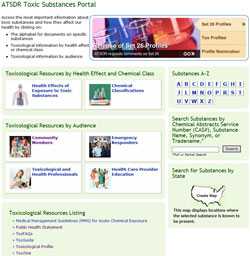ATSDR’s Toxic Substances Portal

ATSDR’s Toxic Substances Web Portal makes it easy for researchers and individuals to find information about toxic chemicals, understand how these chemicals can affect health, and learn how to prevent exposure.
The Environmental Protection Agency (EPA) and the Agency for Toxic Substances and Disease Registry (ATSDR) prepare the National Priority List (NPL). The NPL is a “list of national priorities among the known releases or threatened releases of hazardous substances, pollutants, or contaminants throughout the United States and its territories. The NPL is intended primarily to be a guide to determine which sites warrant further investigation.”
The Comprehensive Environmental Response, Compensation, and Liability Act (CERCLA), commonly known as the Superfund Act, requires ATSDR to create toxicological profiles that examine hazardous substances on the NPL. ATSDR began making the profiles and other products available on its website. Initially, toxic substance information was organized by publication, so only those with prior knowledge of ATSDR publications could locate substance information easily.
It was discovered that most users look for information by substance name and, therefore, could not easily locate the wealth of information available on the website. So, in the fall of 2010, the Toxic Substances Portal was launched to provide an easy, user-friendly “one-stop shop” for anyone seeking information on the health effects of toxic substances. The portal provides comprehensive access to the best science and the latest research for approximately 300 chemical substances.
Asbestos, formaldehyde, arsenic, lead—many of us know that these substances are potentially dangerous. But do we know the levels at which they become toxic or the specific health effects of exposure? What about the toxic substances we hear about in the news—mercury in canned tuna, BPA in plastic, cadmium in jewelry? You can go to the Toxic Substance Portal to learn about the health hazards of these substances and the dangers of exposure.
The Toxic Substances Portal features clean lines, text matched to graphics, and three featured sections with easy click access to a large amount of health effects information. There is a search engine that facilitates finding substances by substance name, CAS number (Chemical Abstract Service registry number), synonym, or trade name. Users are also able to search for substances in other ways:
Toxicological resources are arranged by:
- Health effect – substances that may cause cancer and/or have effects on organ systems (e.g., cardiovascular or respiratory systems) and
- Chemical class – metals, pesticides and volatile organic compounds.
Toxicological resources are tailored by audience:
- Community members who seek simple but accurate information about chemicals and their health effects;
- Toxicological and public health professionals who want specific information about toxicity and associated health risk levels;
- Emergency responders, emergency department physicians and other professionals who manage sudden chemical exposure incidents;
- Healthcare providers who can use free evidence-based medical education courses addressing the clinical health effects of hazardous substances.
Toxicological resources are tailored by product:
- Toxicological Profiles (TP): detailed synthesis of the peer-reviewed scientific literature on the toxicological and adverse health effects of each substance;
- Public Health Statements (PHS): plain language summary overviews of each toxic substance profile, including exposure health effects;
- ToxFAQs: fact sheets written in plain language that answer the most frequently asked questions about a toxic substance and its health effects;
- Case Studies in Environmental Medicine (CSEM): self-instructional courses designed to teach primary care providers about hazardous substances and how to evaluate patients potentially exposed to them.
Take a look at the Toxic Substances Portal today!
- Page last reviewed: March 14, 2017
- Page last updated: March 14, 2017
- Content source:
- Agency for Toxic Substances and Disease Registry
- Page maintained by: Office of the Associate Director for Communication, Digital Media Branch, Division of Public Affairs




 ShareCompartir
ShareCompartir
